drone dangers, risks and injuries
When the topic of the dangers arising from drones is discussed, there are often two radically different points of view. One side is completely disinterested in the topic and for the others the copters are dangerous weapons that should be forbidden.
This technical article is a rational analysis of the hazard potential of the drone and suggests solutions and countermeasures.
Attention: At the end of this article there are illustrations of injuries caused by drones. If you are squeamish, do not scroll to the end of the article. Another warning is shown further down.
The main sources of danger on a drone are :
- kinetic energy of an impact
- propeller
- storage battery
The risks in detail:
kinetic energy of an impact
The energy of an impact can be calculated by using the formula for kinetic energy:
m: weight of the model in kg
v: Speed of the model in m/s
E_kin: Kinetic energy in Joule
The weight of a model plays a secondary role compared to that of its speed. If you double the weight of a drone you also double the kinetic energy on impact, but if you double the speed, you quadruple the kinetic energy..
example of calculation based on a DJI Phantom 2
Given favourable conditions the "DJI Phantom 2" can reach a speed of 80 km/h (22 m/s) in a dive. Given a weight of 1.0 kg this results in 247 Joule of kinetic energy on impact.Calculation based on a Hotliner:
A typical Hotliner (Surface model, mass 1.0 kg, speed ca. 250km/h (69 m/s) would have 2411 Joule on impact. This is 10 times the energy compared to that of the DJI.Dangers on impact
As comparison the projectile from an airgun in Germany has a maximum of 7.5 Joule, measured at the muzzle (aka. Muzzle energy).Even though a drone unleashes a certain amount of energy on impact, the structure of the apparatus is such that the energy does not work in a puncual manner. The structure is simply not rigid enough and becomes deformed. The only exception to this is the motors which are compact and stable enough to inflict considerable damage.
The risks caused by the propellers
The risks caused by the propellers applies specifically to the following:- Cutting damage caused by physical contact to the propeller
- Cuts and stab injuries caused by broken propeller blades
- Hearing damage by the propellers
As the propellers have sharp edges, cuts should not be underestimated and can cause deep wounds. When the model is in motion cuts and lacerations are common. Even smaller propellers (e.g. 5") can cause serious injuries. Larger propellers (8" and bigger), especially those made of carbon fiber (CFRP), can cause deep wounds and easily sever skin, tendons, ligaments and bloodvessels. It should be perfectly clear to everybody that propellers cause deep wounds that bleed heavily and leave scars.
Many pilots are not aware of the power that lies in their propellers. Watch this video and see for yourself
Takeoffs and landings from the hand is careless
Pilots who let the model take off and land from their hands are especially vulnerable to injury, this is simply careless!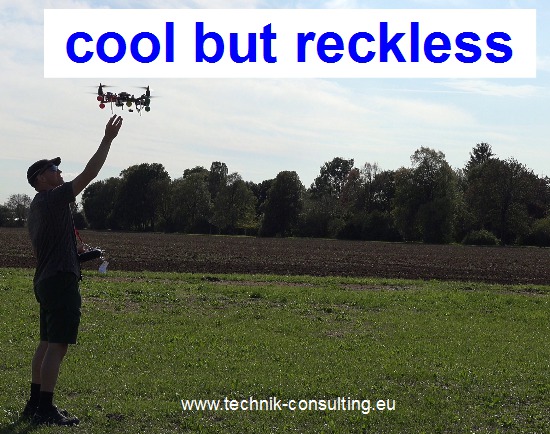
Take the following into consideration regarding hand held take-offs or landing.
- A middle class model takes less than 0.3 seconds to rotate from a horizontal starting position to the vertical and therewith into the arm or face of the pilot. This leaves NO time whatsoever for any reaction from the pilot.
- Even smaller models can develop astonishing power in a short period of time. Then it is no longer possible to hold a even a supposedly safely held model.
- The pilot has only one hand left over for the remote controls giving a restricted ability to react.
- A gust of wind can move the model towards the pilot.
- The model is very close to vulnerable parts of the anatomy such as face, throat and forearm.
Injuries to a realistic hand out of ballistic gelatin
These illustrations show the injuries caused by a propeller to a realistic model of a hand and forearm.The model is made out of high grade ballistic gelatine which is used for such tests by testing institutes and military organisations. The ballistic gelatine has the same characteristics as human tissue such as skin and muscle. Only cut wounds that would sever bone are not realistically covered by such tests as there are no bones in the gellatine model.
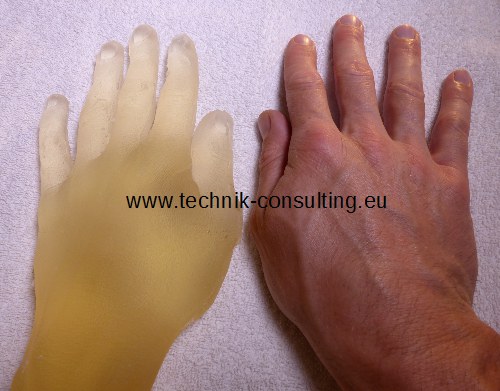
Everything still on the ballistic gelatine model
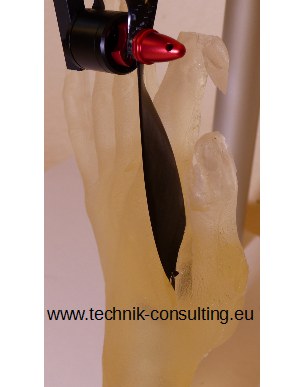
A deep cut between the thumb and the index finger by a carbon fiber (CFRP) propeller. As there are no bones in this position the wound in the ballistic gel corresponds to that of a real hand.
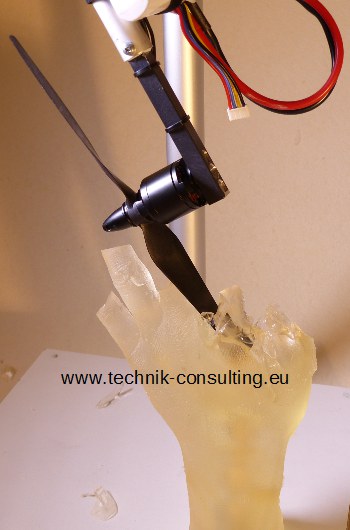
Deep cuts.
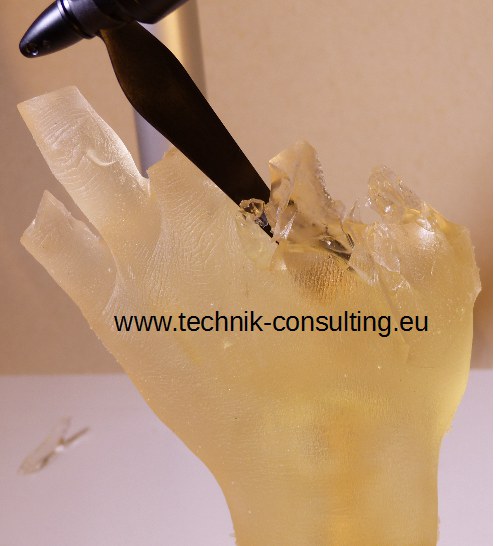
The fingers are now amputated
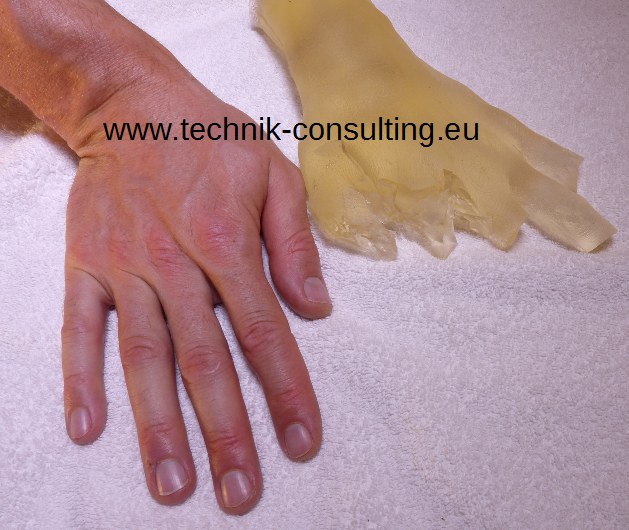
The comparison with the original.
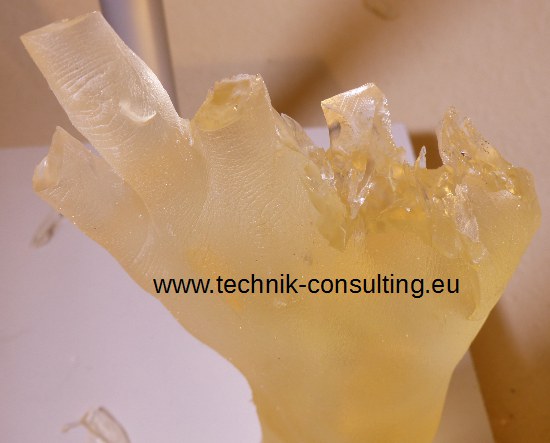
What is left of the ballistic gel hand model
In reality the bones would give the propellers somewhat more resistance and probably prevent the complete amputation of the fingers. Despite this serious injuries are to be expected. In addition to the injury to blood vessels which would cause heavy bleeding, the severing of nerves would lead to permenent loss of feeling in the fingers. Such wounds in the face are much especially dangerous.
Free flying propeller fragments
The danger of injury caused by fragments of propellers flying around has dropped dramatically in the last few years. Due to improved production techniques and the use of more durable materials this risk can now be rated as low. Despite this fact damaged propellers should be replaced. This is especially valid for carbon fiber (CFRP) propellers that have had contact with obstacles. The carbon fiber (CFRP) propellers can appear externally almost undamaged, but have internal fractures that would result in complete destruction under high load. Glass-fiber reinforced plastic (GFRP) propellers are less affected by this, but as with other propeller types, to be on the safe side, should be replaced by visible or expected damage. The cost of a propeller is only a fraction of the cost of the total model, but when a drones propeller is destroyed it leads to crash of the whole model.Hearing damage by propellers at high revs
Hearing damage by propellers is rare and predominantly caused by smaller propellers at high revs in acoustically hard surroundings e.g. concrete walls. This is for example the case when the model is flying close to the pilot in an underground garage.LiPo (Lithium polymer) batteries as risk factor
Another source of danger is from the rechargeable batteries. Modern Lithium polymer batteries have a high energy content. In the case of a crash where the battery is either damaged or where a short circuit happens because the electronics is damaged there is an immediate danger of fire. Especially pilots flying their drones in summer in a dry environment should be specifically consious of this risk. If a Lithium polymer battery is on fire it should never be attempted to be extinguished with water. Instead a fire blanket, sand or a powder extinguisher should be used. The practical solution is to take a simple fire blanket with you when flying high performance models.The simple solution : keep your distance
Takeoffs and landing manoeuvres on the ground and with 5 meters safety distance to all people should be the preferred solution.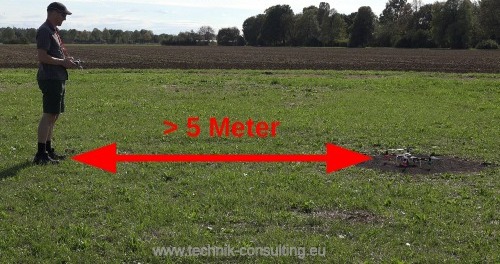
The risk of injury is 1% when there is 5 metres to the model, and when the drone is fly in an uncontrolled manner. With 10 metres distance the risk is reduced to 0.25% (calculation see below)
Risk minimisation when flying drones.
To minimise the risks simply adhere to common sense.- Only fly models that are intact and in working order. No 'with some luck' flights.
- Pre-flight checks of what risks or obstacles, if any, there are.
- Fly with generous safety distance to people and animals. Dogs like chasing low-flying drones and jump up to catch them.
- Read and adhere to the models operating instructions.
Fail-Safe scenarios - there is only one safe scenaro
A couple of comments on some different Fail-Safe scenarios. GPS is only precise under optimal circumstances. Trees, buildings, thunderclouds etc can negatively affect the reception. We have tested premium quality GPS receivers and under adverse conditions, e.g. rain clouds have seen differences of up to one kilometer compared to the correct position. These receivers do correct the position incrementally, but in unfavourable cases the control system can have an incorrect position. A flight over a longer distance with a drone is then dangerous.In my opinion there is only one reliable fail-safe behaviour: Turn off the motors immediately. Even when under some circumstances this means that the model is a total loss. All other scenarios such as "Position hold", "Fly Home" etc are hazardous. Consider the fact that there must be a problem that activates such scenarios. No radio reception means that there is generally reception problems which can also affect the GPS signal reception. A model flying around in an uncontrolled manner can cause more damage than a model that simply falls onto a small area. As good as the GPS functionality is, it should not be blindly relied upon.
Typical sources of errors with drones
A few possible reasons for uncontrollable flights- Propeller incorrectly assembled
- Motors rotate wrong
- Cable break
- Moisture on the circuit board (rain, fog, snow)
- A radio broadcasting close by disrupts the signal
- Controller incorrectly configured
- Wiring error (e.g. Motor incorrectly connected to the controller)
Further possible causes
- Pilot over steers the model
- Pilot is jostled
- Pilot sneezes
- Gust of wind
- a connector plug becomes loose
- Defect remote control
- Pilot is distracted
- ESC short circuit
- and many more
What is the background to this article?
This article was written because some drone flying friends have been injured, some seriously, while practising their hobby or profession - and I want you to avoid this !
Please do not hesitate to get in touch if you have any questions.
Derivation hit probability
To calculate of the probability of getting hit by a model that is out of control we can use the following method.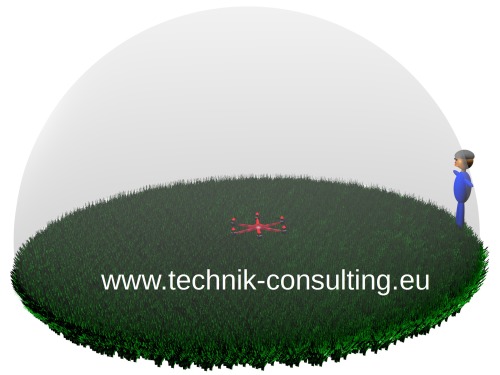
Suppose that the model is placed in the middle of a hemisphere. The pilot is exactly on the border of the hemisphere. A model that is out of control will 'crash' either on the ground or on the surface of the hemisphere.
The area of the circular floor of the hemisphere is :
Where R is the radius of the circular base and that of the hemisphere and denotes the distance to the model.
We will assume that the Pilot has the dimensions of 180 cm x 50 cm. To simplify the calculation without losing accuracy we will assume that the model is punctiform. Because of this last assumption, we will add the half of the dimensions of the model to each side of those of the pilot. In total the dimensions of the pilot flying a model with the overall dimensions of 50cm (propeller tip to propeller tip) are then 230 cm x 100 cm, which equates to 2.3 m².
The probability of being hit is the relationship of the areas to each other.

In the example calculation the probability of being hit with a 5 m initial distance to the model is ca. 1%
The following table shows typical values for the probability of being hit by a drone out of control against the initial distance to the model
| distance in m | probability of being hit in % |
|---|---|
| 1 | 24,40 |
| 2 | 6,10 |
| 5 | 0,98 |
| 10 | 0,24 |
| 20 | 0,06 |
| 50 | 0,01 |
Attention: Some pictures of injuries by drones are shown below. If you are squeamish and cannot bear the sight of blood, do NOT scroll down.
Pictures of injuries from drone accidents
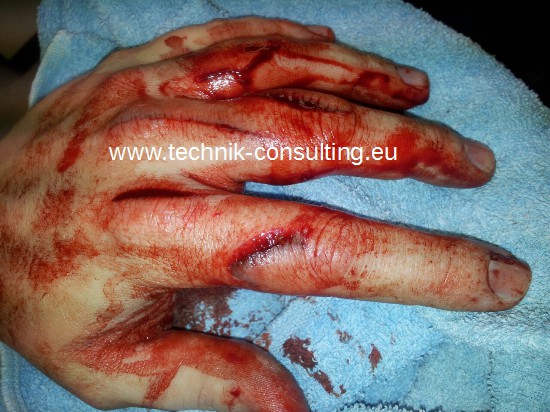
Propeller incorrectly attached and a take-off from the hand. The cuts only just avoided the nerves.
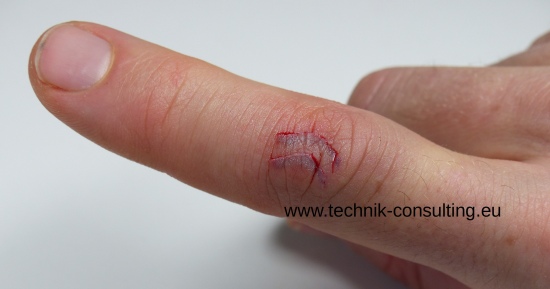
Small FPV Racer: Pilot wanted to lift the armed model. On stooping the thick winter jacket pressed the throttle stick slightly forward and the engines started. Two cuts to the bone / joint. Injury of extensor tendon forefinger.
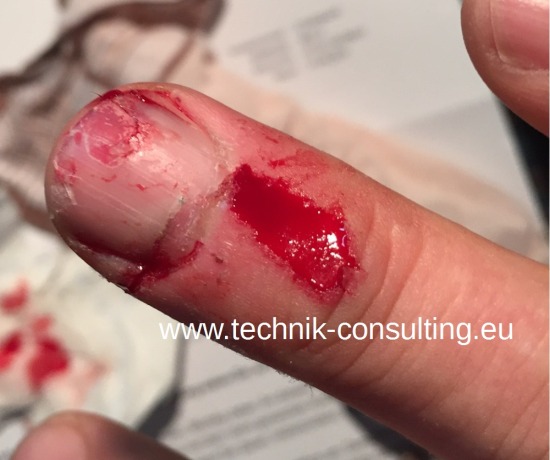
250er Racer: When bending and reattaching the quadrocopter with the clothes the gas lever touches. Surface injury and injury to the nail, but fortunately not deep.
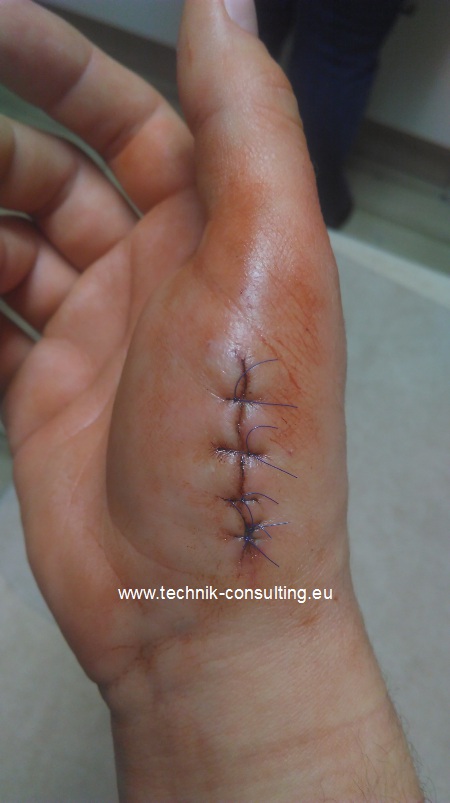
This injury arose when the drone was caught out of the air. A propeller hit the hand. 2204 motor with 6 inch propeller.
If you have been injured by a drone and posess pictures, feel free to send these. Ideally with a brief description and a written permission to publish the pictures on the website.
Please use the contact address to send the pictures.
